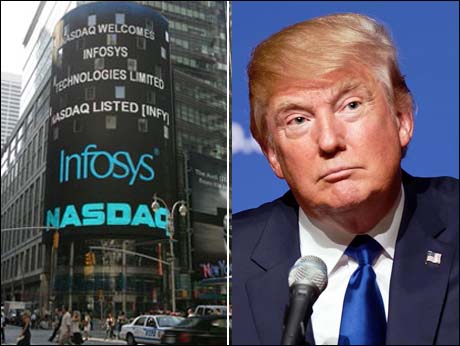
Bangalore, November 10 2016: What will be the impact of a Trump Presidency on the Indian Infotech industry -- partricularly on the key players who have US operations.
We bring you some early views of analysts:
Zinnov Consulting:
For the Indian outsourcing industry, which has always been overly reliant on North America, with NA bringing up 60% of the $82 bn software export revenue for the industry, clearly, a fresh perspective in the industry is needed and changes in the US administration should be seen as an opportunity to bring about the same.
Here is a set of pointers on how the recent developments can affect the Outsourcing industry:
Kotak Institutional Equities
Indian IT is better-prepared to manage potential changes courtesy increase in local hiring, local acquisitions and continued increase in US wages. On a relative basis, HCLT and Wipro have lower risks than Infosys and TCS.
Indian IT derives 54-62% of revenues from North America. Specifically, TCS derives 54%, Infosys 61.5%, HCLT 62% and Wipro 56% of revenues from the North American market. Visa dependency is high; we estimate that 50-80% of US workers (excluding headcount of acquisitions done in US by Indian IT) will be H-1B/L-1 visas. Any disruption to visa rules can have negative implications for Indian IT.
Current status of US headcount of Tier-1 IT companies
Annual filing by with the SEC indicates that Infosys had 14,659 employees on H-1B visas and 1,364 employees on L-1 visas in the US at end-FY2016. Based on back-of-the-envelope calculations, Infosys indicates a rather high visa dependence. Interestingly enough, Infosys also has the highest per-capita onsite wage in the industry. TCS historically had a high visa dependence although it would have reduced in the past three years given that the company has stepped up local hiring. Based on the statements in the past, we would not be surprised if HCLT’s local headcount in US is close to 50%. Wipro’s last disclosed local headcount was ~40% in the US. The ratio between visa holders and locals would have remained steady or increased marginally in favor of locals. Additionally, acquisition of Apperio and HPS provides additional ~4,000 local headcount in the US. Tech Mahindra’s acquisition of LCC (with over 3,000 local US employees) increases local presence; however, dependence on visas is high for core IT services.
It is too early to comment on implications of the US elections. However, one of the possibilities in future could be increase in minimum wages for H-1B workers from the current US$60,000. This can impact earnings if the increase is material even as we highlight that the average per-capita compensation of H-1B worker is materially higher than the minimum wage threshold. We also note that Indian IT’s H-1B worker compensation has increased in the past three years due to visa shortage and high attrition levels.
Arup Roy, Research Director, Gartner
Indian IT sector must now brace for further troubled times ahead. The sector was already battling both cyclical challenges (due to changes and shifts in financial services, healthcare verticals) as well as secular challenges (i.e., cloud shift, automation, pricing pressure, insourcing) impacting revenue growth. A sub 10% growth for FY2017 is certain. Now with Donald Trump, administration will add to the industry’s woes. Trump administration's protectionist views would have further dampening impact on growth prospects, if the views were to crystalize into some serious policy implementations. However, what happens during campaigns and what actually transpires in office can vary greatly and we did get early signs of that in his victory speech, but at minimum it is headline risk and adds to the uncertain times.